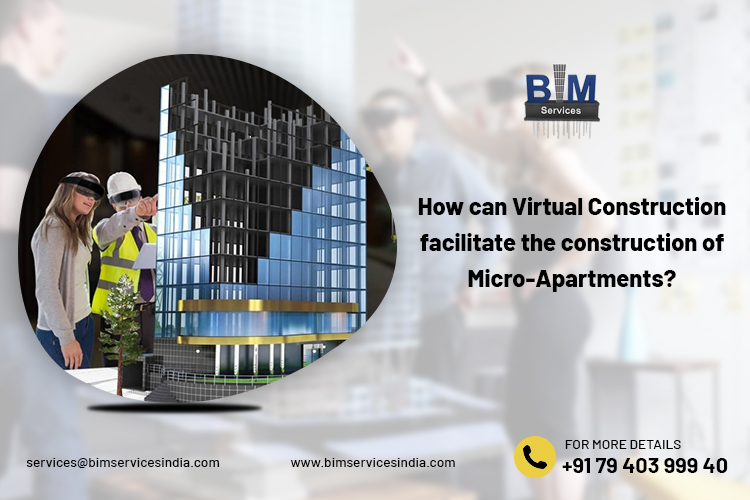How can Virtual Construction facilitate the construction of Micro-Apartments?

With more people migrating to cities there is a dire need for good and economical rental space. With this dearth of space posing some serious issues it came upon the construction sector to find more innovative solutions. On top of it there is also the growing trend of people who opt to live by themselves like students, young professionals etc. who want central located places in a stipulated budget. Keeping all this in the mind, architects, engineers and designers have come up with the possible solution in the form of micro-apartments.
Micro-apartments are around the size of an average garage, ranging from as 200 square feet to 400 square feet in size (19 and 37 square meters). Though tiny, they are optimally designed in such a manner that they have all the basic necessities of a studio from a place for sitting and sleeping as well as a kitchenette, a bathroom and a limited amount of storage. Since, every inch of the space must be properly utilized as well as it’s aesthetic appeal shouldn’t be compromised on, to build them in quick time and with good profit margins is a major task for the construction professionals.
Table of Contents
We will, in this blog, be looking at the challenges that are faced during the construction of micro-apartments and how virtual construction could be lucrative and time saving.
Optimal Design:
The very aim of micro-apartments is to maximize on the available square footage as much as possible which involves extensive designing. The space can be divided across various levels so that more utilities can be added. Moreover, it is also a difficult task to ensure that the apartment doesn’t not appear small and cramped. This can be achieved by using high ceilings to make the small square footage appear larger. It could also have large windows, open layouts, light colors etc. It is very difficult to actually understand how the final design will look and feel like and hence, virtual construction is extremely essential. For the designer it allows them to try out multiple design options, color, material selections and check the resultant effect easily on the overall look of the apartment. Architectural BIM Services also can be used for client and stakeholder presentations where in the architect can efficiently communicate his final design.
Code-specific building design:
The very idea of creating buildings in smaller spaces is so that more number of individual units can fit in the available space. This would also lead to more number of tenants packed in a given space. Thus, there will need to be regulations controlling unit size, the location of the building site as well as strict monitoring of the building codes concerned with safety of the tenants as well as with regards to parking, traffic etc. BIM technology and its various plug-ins can help the AEC professions in ensuring that the building is according to the relevant codes and also enables them to explore alternative design options in the virtual 3D environment also.
Revit Families for multi-functional elements:
What is common in most micro-apartments is the use of multi-purpose elements like a murphy bed which can fold into the wall or an ottoman which can also be used as a table etc. These can be either as simple as a nesting table or folding chairs that can be hanged on the wall or they can be more complex designs like a “land peel”. Created by a Japanese industrial design student, it is basically a flat mat made up of three pieces which can be configured to make a table, seat or bed. Revit Family Creation Services can be beneficial to create these unique parametric elements which can be used in the particular project design or even be loaded into different project models. Since, Revit families are data rich it also becomes possible to provide all the information like material specifications, dimensions, manufacture’s details etc.
Modern Technology for cost-effectiveness:
Finally, the biggest appeal of micro-apartments is that they are economical and hence the building construction should always keep the budget factor in mind. The very model of BIM saves cost as it lets all the stakeholders remain on the same page so that unnecessary mistakes arising due to miscommunication are avoid. With BIM, it is also possible to detect clashes, avoid errors and needless waste of resources. 5D BIM also allows to gain exact costing right from the start and reflects any cost alterations which could arise as a change of materials or design changes. Finally, prefabrication can also be used to construct the buildings or building off-site in a climate controlled location. In Prefabrication it is essential to note that the components are created of exact dimensions so that they can be assembled without any problems on site. Prefabrication can end up saving approximately 15-20% of the total cost. Currently the reason why the prices of micro apartments is high is due to its scarcity but gradually as restrictions ease more and more micro-apartments will start to increase, price will also decrease.
Conclusion:
The future in the post-pandemic world will definitely see a reduction in co-living spaces and micro apartments could provide a possible alternative. Micro-apartments in centrally located places can enable young professionals to find homes close to work, spend less time on commutes, save money on transportation cost and at the same time satisfy their need of personal space and aesthetic appeal.